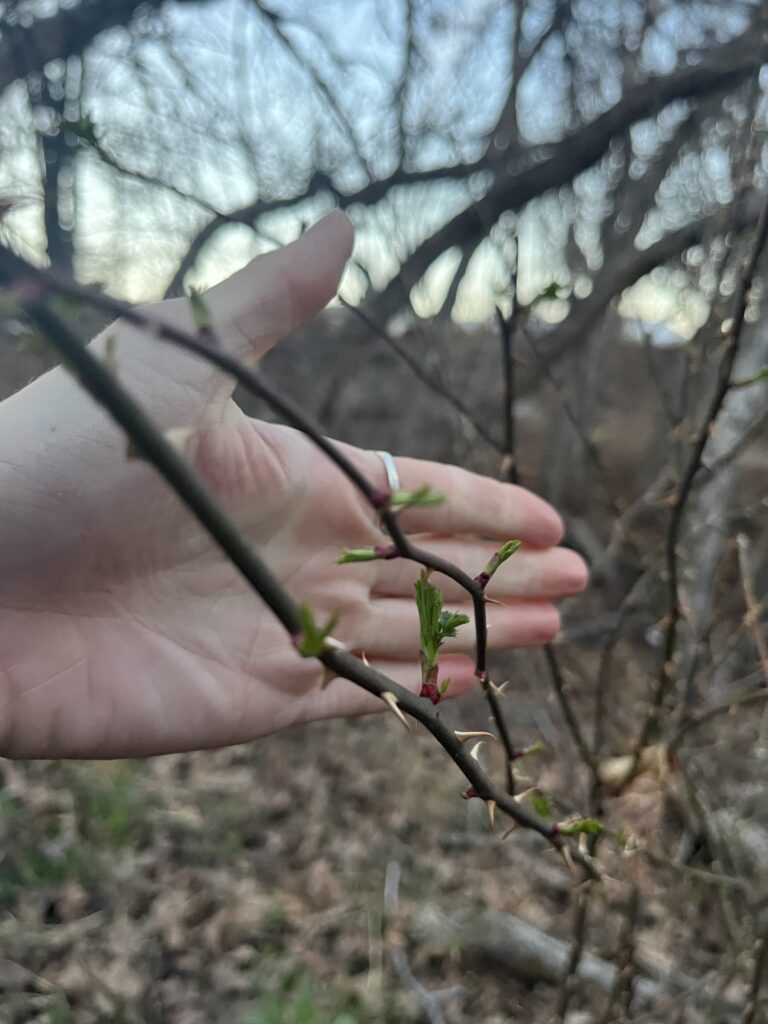
By Mara Scallon, communications graduate assistant in the Sustainability Office
Well, dear reader, I heeded my own advice from my last post and visited Red Butte Creek at a different time than I normally do. I woke up earlier than usual, cycled to campus covered in flashing bike lights and reflective gear and sat alongside Red Butte Creek as the sun rose from behind the Wasatch Mountains.
Heading into “my” site, I was surprised by how unfamiliar it was and how narrow my field of vision was since it was mostly confined to the soft, glowing circle of my headlamp. I walked into thorns I knew were there, I tripped on roots I’ve always stepped over and my helmeted head gently made the acquaintance of a low-slung branch that has been eagerly awaiting this introduction since I first began visiting. The creek was running wider and deeper than I’ve seen, a visible and audible result of the warmer temperatures of the last few days melting the snow high up in the creek’s drainage basin. The squirrels and the birds near the creek were quiet, with only a single song sparrow (Melospiza melodia) chirping after the sun had risen, but not before then.
I came away from my early morning visit with a smile on my face, appreciating how the beautiful colors of the sunrise unfolded slowly during my hour by the creek and feeling energized by watching this small corner of the world wake up. With my headlamp now off as I left my spot, the bright sky made the world feel familiar again, and I no longer bumped into the various plant residents as I retreated.

The riparian (creekside) world along Red Butte Creek is not the only part of my world where I am seeing things differently. As I think about the onset of Earth Month and the many on-campus activities happening throughout, I recognize the value of such events since they bring attention to different facets of sustainability, the natural world, scientific research or the human experience that might not otherwise be seen. As I revise my scrawled list of potential fall classes in which to enroll, I recognize that the different classes I’ve already taken these last two semesters have helped me see environmental challenges and sustainability pathways with more nuance, context and criticism.
Perhaps most importantly, my continual seeing anew of the world around me forces me to see myself in a new way, as well: I am not quite the same student or local or global citizen that I was when I began my program in Environmental Humanities last August, and I am not sure how those aspects will change further by the time I graduate in May 2026. As I imagine what Red Butte Creek will look like when the green growth sprouts, when the leaves burst forth, when the creatures reproduce and rear their young in earnest during the warm and abundant months, I imagine in what different way I will be sprouting, bursting forth with ideas and supporting my communities. I’m excited to see where this journey continues to take me.

I am not the only one who has been on a journey during this blog series—I hope that you’ve been following along with me. Hopefully, you’ve followed along by reading, but more importantly, by finding your equivalent Red Butte Creek spot. So to you, I ask: where is your own special outdoor spot? Have you read these posts wishing you could find your own outdoor space to dawdle around, to dwell within, to observe? Or maybe you’ve gone out and found your spot—was it surprising? Boring? Just okay? Or maybe you’ve kind of found a spot, kind of haven’t. Maybe you’re just starting to notice the non-human world around you more, even if you don’t have one special place you keep going back to. There’s no wrong answer. I just hope the changing season nudges you to spend a little more time outside.
As spring fully raises her greening head, we notice the chirps and trills of birds sailing through the air, we watch the crabgrass green and grow seemingly overnight, we inhale deeply when passing near flowering trees to drink in their sweet perfume. We may be noticing more changes in how the world looks around us, with many more greens and pastel-hued buds and flowers appearing. We may observe birds flitting around certain spots, perhaps foraging before returning to their nests and their young. We might be seeing our own pet cats and dogs shedding as temperatures trend upward.
Within our human world, we may notice a multiplying of folks commuting by bike, we might be eyeballing outdoor thermometers to determine when our seedlings ought to be planted into the ground and we may be caught unawares by the late evening hour since it is still light out. As we fully enter a new season, this may be the opportunity we have all been looking for to find our own Red Butte Creek spot, to think about changing our spot as our schedules race toward the summer and to take stock of the different ways we engage with the non-human world at different times of the year. For myself, I am planning a different sort of visit to Red Butte Creek for the finale in this school year’s series, so I hope you’ll accompany me on that journey in the next blog post.

